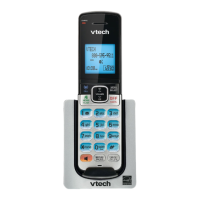
Do you have a question about the VTech DS6621 and is the answer not in the manual?
| DECT frequency | 1921.536-1928.448 MHz |
|---|---|
| Bluetooth frequency | 2402.000-2480.000 MHz |
| DECT channels | 5 |
| Bluetooth channels | 79 |
| handset battery voltage | 2.4 V |
|---|---|
| charger voltage | 6 V |
| charger current | 300 mA |
| phonebook memory locations | 1000 |
|---|---|
| phonebook digits capacity | 30 digits |
| phonebook characters capacity | 15 characters |
| caller ID log memory locations | 50 |
| caller ID log digits capacity | 24 digits |
| caller ID log characters capacity | 15 characters |
Lists all items included in the telephone package for unboxing and setup.
Step-by-step guide to install the telephone base and charger correctly.
Instructions on how to properly install and charge the battery into the handset.
Initial setup including date, time, and answering system configuration via voice guide.
Guidance for new cable/VoIP subscribers and on using voicemail service.
Instructions for tabletop and wall mount installation of the telephone base unit.
Diagram and explanation of the telephone base controls, lights, and indicators.
Diagram and explanation of the handset controls, LCD display, and icons.
Overview of the telephone system's Bluetooth wireless technology features and benefits.
Key usage guidelines, range, and important information for Bluetooth connectivity.
Definitions of common terms used in the manual related to Bluetooth functionality.
Procedure to pair and connect Bluetooth enabled cell phones and headsets.
Manually connecting previously paired cell phones or headsets, and reviewing the device list.
Instructions to download contacts from a cell phone to the system's phonebook.
How to navigate and use the telephone's menu for accessing settings.
Adjusting handset and base ringer volume and selecting desired ring tones.
Procedure to set the date and time for accurate message logging and Caller ID.
Setting the display language and configuring the voicemail access number.
How to manually clear new voicemail indicators on the handset and base.
Configuring key tones and setting a home area code for Caller ID.
Selecting between touch-tone and pulse dialing modes for making calls.
Detailed steps for making, answering, and handling calls on the home line.
Detailed steps for making, answering, and handling calls via Bluetooth cell lines.
Managing incoming calls when already on a call for both home and cell lines.
Controls for speakerphone usage, adjusting volume, and muting the microphone.
Redialing last numbers and temporarily silencing the handset ringer.
Using chain dialing for sequences and switching to tone dialing temporarily.
Locating misplaced handsets and joining ongoing calls with other users.
Using the intercom feature for internal conversations between handsets.
Transferring external calls and managing incoming calls during intercom use.
General information about the phonebook capacity, sharing, and basic operations.
Procedures for adding new contacts and modifying existing ones in the phonebook.
Browsing, searching alphabetically, and making calls from the phonebook.
Procedures for removing individual contacts or clearing the entire phonebook.
Explanation of the Caller ID service and its requirements for proper function.
Information about the caller ID log, its capacity, and how entries are stored and shared.
How to view, return calls, and copy entries from the caller ID log.
Adjusting number format for dialing and saving caller ID entries to the phonebook.
Methods for deleting single or all entries from the caller ID log.
Overview of the call blocking feature and its applications for rejecting calls.
How to block calls from private or unknown numbers automatically.
Adding numbers, saving from call log, and reviewing the list of blocked numbers.
Procedures for modifying or removing entries from the call block list.
Introduction to the answering system's functions and configuration options.
Customizing the greeting announcement for incoming calls.
How to enable or disable the answering system from the base or handset.
Configuring call screening and the number of rings before the system answers.
Setting remote access codes and message alert tones for new messages.
Using the voice guide for a simplified, step-by-step answering system setup.
Differentiating between built-in answering system and provider voicemail features.
Coordinating the answering system with provider voicemail for seamless message handling.
Information on message storage limits and how new messages are indicated.
Intercepting calls during recording and controlling message alert tone functionality.
Instructions for playing messages from the telephone base or handset.
Procedures for deleting old messages and recording/managing memos.
Explains various displays shown on the answering system's message window.
Commands and procedures for accessing the answering system remotely via phone.
Explains common messages displayed on the handset screen for various situations.
Explains the function and meaning of various lights on the handset and telephone base.
Explains the meaning of icons displayed on the handset screen, including battery status.
Details on battery life, charging times, and essential handling and safety precautions.
Information on adding compatible devices like additional handsets and headsets.
Step-by-step guide to register new or expansion handsets to the telephone base.
Procedures to remove all registered devices (handsets, headsets) from the base.
Solutions for common problems related to Bluetooth, phone operation, and connectivity.
Essential safety precautions for using the telephone equipment to prevent hazards.
Specific safety advice for users with implanted cardiac pacemakers regarding phone use.
Information on the phone's operational range and the power-saving ECO mode feature.
Guidelines for cleaning, avoiding water, and general maintenance of the telephone.
Information regarding the recycling of rechargeable Nickel-Metal Hydride batteries.
Details on FCC, ACTA, and Industry Canada regulations applicable to the device.
Instructions for activating and deactivating the CEC battery charging testing mode.
Details on what the limited warranty covers, its duration, and exclusions.
Key technical data including transmit frequencies, channels, power requirements, and memory.